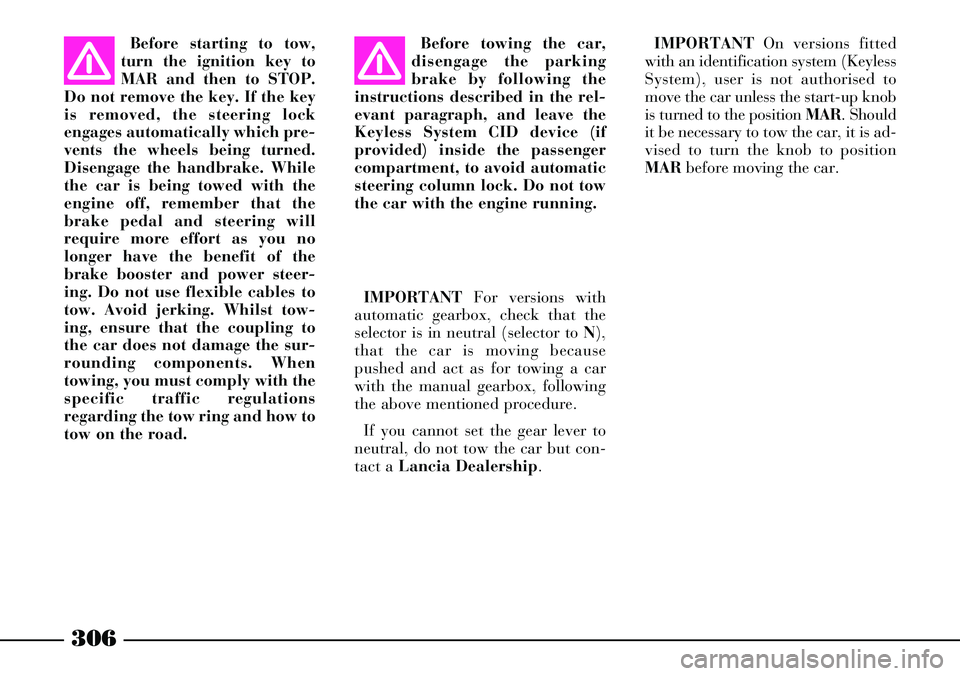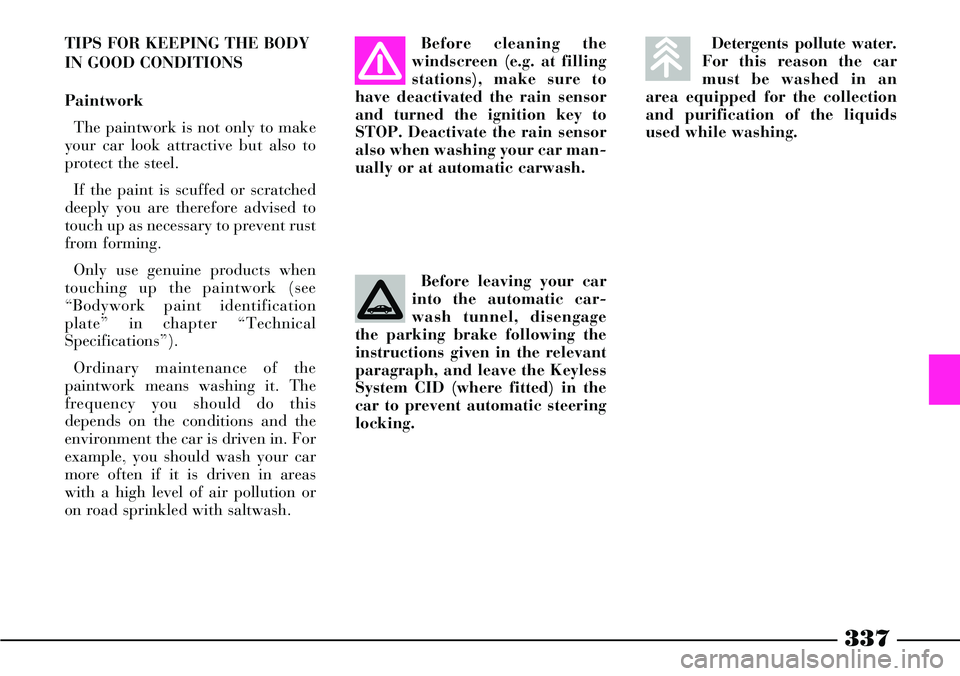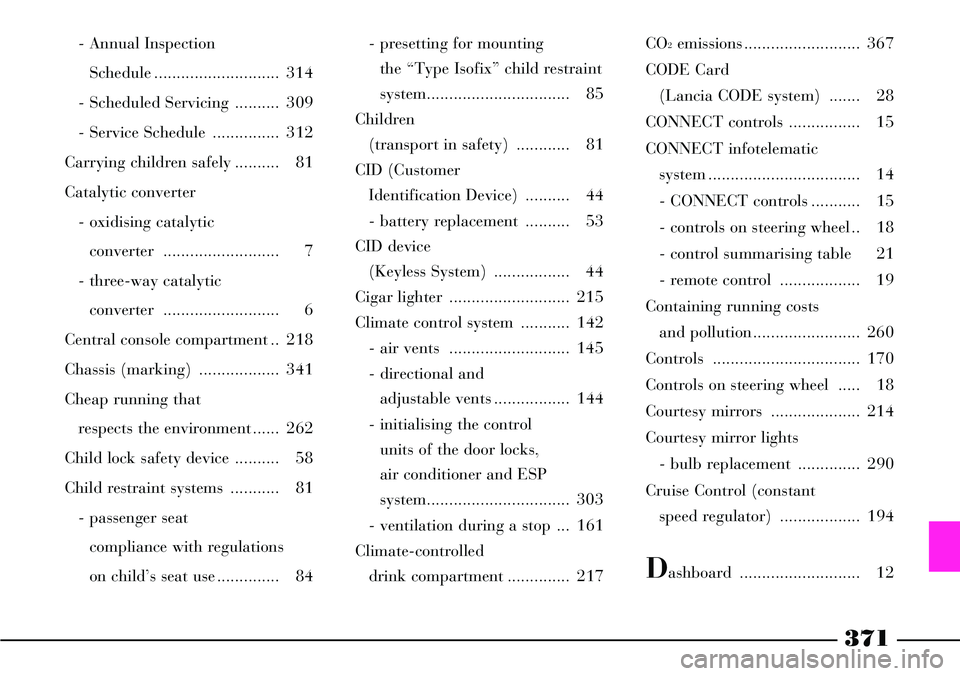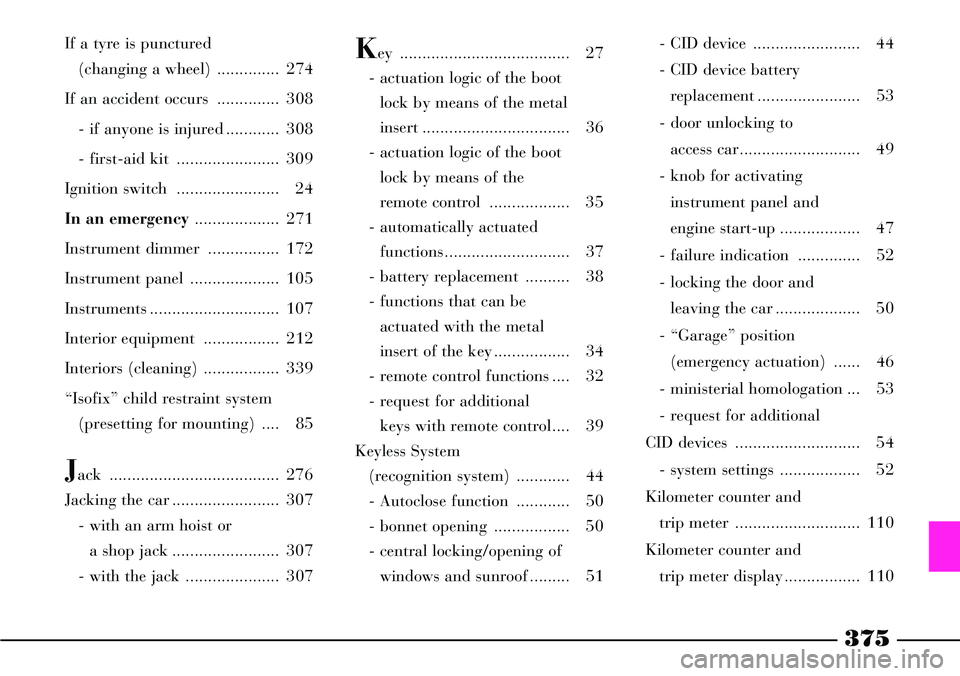key Lancia Thesis 2007 Owner handbook (in English)
[x] Cancel search | Manufacturer: LANCIA, Model Year: 2007, Model line: Thesis, Model: Lancia Thesis 2007Pages: 386, PDF Size: 8.69 MB
Page 307 of 386

306
Before towing the car,
disengage the parking
brake by following the
instructions described in the rel-
evant paragraph, and leave the
Keyless System CID device (if
provided) inside the passenger
compartment, to avoid automatic
steering column lock. Do not tow
the car with the engine running. Before starting to tow,
turn the ignition key to
MAR and then to STOP.
Do not remove the key. If the key
is removed, the steering lock
engages automatically which pre-
vents the wheels being turned.
Disengage the handbrake. While
the car is being towed with the
engine off, remember that the
brake pedal and steering will
require more effort as you no
longer have the benefit of the
brake booster and power steer-
ing. Do not use flexible cables to
tow. Avoid jerking. Whilst tow-
ing, ensure that the coupling to
the car does not damage the sur-
rounding components. When
towing, you must comply with the
specific traffic regulations
regarding the tow ring and how to
tow on the road.IMPORTANTFor versions with
automatic gearbox, check that the
selector is in neutral (selector to N),
that the car is moving because
pushed and act as for towing a car
with the manual gearbox, following
the above mentioned procedure.
If you cannot set the gear lever to
neutral, do not tow the car but con-
tact a Lancia Dealership.IMPORTANTOn versions fitted
with an identification system (Keyless
System), user is not authorised to
move the car unless the start-up knob
is turned to the position MAR. Should
it be necessary to tow the car, it is ad-
vised to turn the knob to position
MAR before moving the car.
Page 309 of 386

308
– In pile-ups on the motorway,
particularly when the visibility is
bad, there is a high risk of other
vehicles running into those already
stopped. Get out of the car immedi-
ately and take refuge behind the
guard rail.
– If the doors are blocked, do not
attempt to smash the windscreen to
get out of the car. It is made of lay-
ered glass and is very hard. Side and
rear window are much more easily
broken.
– Remove the ignition keys from
the vehicles involved.
– If you can smell petrol or other
chemicals, do not smoke and make
sure all cigarettes are extinguished.
– Use a fire extinguisher, blanket,
sand or earth to put out fires no
matter how small they are. Never
use water.
– If it is not necessary to use the car
light system, disconnect the negative
terminal (–) from the battery pole.IF ANYONE IS INJURED
Never leave the injured person alone.
The obligation to provide assistance
exists even for those not directly in-
volved in the accident
– Do not congregate around the in-
jured person
– Reassure the injured person that
help is on its way and will arrive soon.
Stay close by to calm him/her down
in case of panic
– Unfasten or cut seat belts holding
injured parties
– Do not give an injured person any-
thing to drink.
– Do not move an injured person un-
less the following situations arise
– Pull the injured person from the
car only if it risks catching fire, it is
sinking in water or is likely to fall over
a cliff or similar. Do not pull his/her
arms or legs, do not bend the head
and, as far as possible, keep the body
horizontal.IF AN ACCIDENT
OCCURS
– It is important to keep calm.
– If you are not directly involved in
the accident, stop at least ten metres
away from the accident.
– If you are on a motorway do not
obstruct the emergency lane with
your car.
– Turn off the engine and turn on
the hazard lights.
– At night, illuminate the scene of
the accident with your headlights.
– Act carefully, you must not risk
being run over.
– Mark the accident by putting the
red triangle at the regulatory dis-
tance from the car where it can be
clearly seen.
– Call for rescue making the infor-
mation you give as accurate as you
can. On the motorway use the spe-
cial column-mounted emergency
phones.
Page 317 of 386

316
IMPORTANT - Diesel filter
The different grades of purity in
diesel fuel normally available might
make it necessary to replace the fil-
ter more frequently than indicated
in the Service Schedule. If the engine
misfires it shows the filter needs
changing.IMPORTANT - Dust/pollen filter
If the car is often used in dusty or
extremely polluted environments,
you should change the filter element
more frequently. It should be
changed especially if the amount of
air introduced into the passenger
compartment is reduced.IMPORTANT - Battery
The charge in your battery should
be checked, where possible at the
start of the winter, to limit the risk
of the battery electrolyte freezing.
This check should be carried out
more frequently if the car is mainly
used for short trips or if it is fitted
with accessories that permanently
take in electricity even when the
ignition key is removed, especially in
the case of after market accessories.
If the car is used in very hot cli-
mates or particularly demanding
conditions check the battery elec-
trolyte more frequently than shown
in the “Service Schedule” in the
“Car maintenance” chapter.
Page 330 of 386

329
USEFUL ADVICE FOR
LENGTHENING THE LIFE OF
YOUR BATTERY
To prevent rapidly draining the
battery and ensure that it continues
to work correctly, the following
should be noted:
– Terminals must always be firmly
tightened.
– Do not keep accessories (e.g.
sound system, hazard lights, parking
lights, etc.).
– When you park the car, ensure
the doors, boot and bonnet are
closed properly. The ceiling lights
must be off.
– Before working on the electrical
system, disconnect the negative
cable from the battery.– If after buying the car, you want
to install electric accessories which
require permanent electric supply,
visit a Lancia Dealership, whose
qualified personnel, in addition to
suggesting the most suitable devices
belonging to the Lineaccessori
Lancia, will evaluate the overall
electric absorption, checking
whether the car’s electric system is
capable of withstanding the load
required, or whether it should be
integrated with a more powerful
battery. These devices in fact take
electricity also when the ignition key
is removed (car parked, engine off),
and can gradually drain the battery.
The overall intake of these devices
(standard and after-market) must
be less than 0.6 mA x Ah (of the bat-
tery), as shown in the following
table.Battery Maximum
idle intake
70 Ah 42 mA
80 Ah 48 mA
100 Ah 60 mA
It is also important to remember
that high intake devices (such as
bottle warmers, vacuum cleaners,
cellular phones, frigo bar, etc.) will
speed up battery discharging when
powered with engine off or running
idle.
– Please note that when installing
additional systems in the car, incor-
rect wiring can be dangerous espe-
cially when concerning safety sys-
tems.
Page 331 of 386

330
SPARK PLUGS
The cleanness and soundness of the
spark plugs are very important for
keeping the engine efficient and pol-
luting emissions down.
The appearance of the spark plug,
if examined by expert eyes, is a good
way of pinpointing a problem even if
it has nothing to do with the ignition
system. Therefore, if the engine has
problems, it is important to have the
spark plugs checked at a Lancia
Dealership.
The spark plugs must be
changed at the times
specified in the Service
Schedule. Only use the type of
plugs indicated. If the heat ratio
is less than required or the life
specified is not guaranteed, prob-
lems can arise.
ELECTRONIC
CONTROL UNITS
When the car is being used normal-
ly, special measures are not neces-
sary.
The following instructions must be
followed very carefully, however, if
you work on the electrical system or
in cases where emergency starting is
necessary:
– never disconnect the battery from
the electrical system while the
engine is running
– disconnect the battery from the
electrical system if you are recharg-
ing it. The modern battery chargers
can discharge voltage up to 20V
– never perform emergency start-
ups with a battery charger. Always
use an auxiliary battery
– be particularly careful when con-
necting the battery to the electrical
system. Make sure that the polarity
is correct and that the connection is
efficient– do not connect or disconnect the
terminals of the electronic control
unit while the ignition key is at MAR
– do not check polarity through
sparking
– disconnect the electronic control
units if you are electrically welding
the car body. Remove the units if
temperatures exceed 80°C (special
operations on the bodywork, etc.).
Modifications or repairs
to the electrical system
carried out incorrectly
and without bearing the features
of the system in mind can cause
malfunctions with the risk of fire.
Page 338 of 386

337
Detergents pollute water.
For this reason the car
must be washed in an
area equipped for the collection
and purification of the liquids
used while washing.TIPS FOR KEEPING THE BODY
IN GOOD CONDITIONS
Paintwork
The paintwork is not only to make
your car look attractive but also to
protect the steel.
If the paint is scuffed or scratched
deeply you are therefore advised to
touch up as necessary to prevent rust
from forming.
Only use genuine products when
touching up the paintwork (see
“Bodywork paint identification
plate” in chapter “Technical
Specifications”).
Ordinary maintenance of the
paintwork means washing it. The
frequency you should do this
depends on the conditions and the
environment the car is driven in. For
example, you should wash your car
more often if it is driven in areas
with a high level of air pollution or
on road sprinkled with saltwash.Before leaving your car
into the automatic car-
wash tunnel, disengage
the parking brake following the
instructions given in the relevant
paragraph, and leave the Keyless
System CID (where fitted) in the
car to prevent automatic steering
locking.Before cleaning the
windscreen (e.g. at filling
stations), make sure to
have deactivated the rain sensor
and turned the ignition key to
STOP. Deactivate the rain sensor
also when washing your car man-
ually or at automatic carwash.
Page 340 of 386

339
Engine compartment
At the end of each winter season,
carefully clean the engine compart-
ment without directing the water jet
against electronic control units.
Have this done at a garage.
Detergents pollute water.
For this reason the car
must be washed in an
area equipped for the collection
and purification of the liquids
used while washing.
IMPORTANTThe car should
washed with the engine cold and the
ignition key at STOP. After washing
make sure that the various protec-
tions (e.g. rubber caps and various
covers) have not been damaged or
removed.INTERIORS
From time to time check that water
has not collected under the mats
(from dripping shoes, umbrellas,
etc.) which could cause the steel to
rust.
Never use inflammable
products like fuel oil
ether or rectified petrol
for cleaning inside the car. The
electrostatic discharges generat-
ed when rubbing to clean may
cause fire.
Do not keep aerosol cans
in the car. There is the
risk they might explode.
Aerosol cans must never be
exposed to a temperature above
50°C; when the weather starts to
get hot the temperature inside the
car might go well beyond that fig-
ure.
PLASTIC PARTS INSIDE
THE CAR
Use special products designed not
to alter the appearance of the com-
ponents.
IMPORTANTDo not use alcohol
or petrol to clean the instrument
panel.
CLEANING ALCANTARA
SEATS
Alcantara upholstery is easy to
clean. Follow the same instructions
provided for velvet upholstery.
Page 371 of 386

370
Battery
- checking the battery
charge ................................ 327
- disconnecting the loaded
battery ............................... 302
- disconnecting the
unloaded battery................ 303
- initialising the control
units of the door locks,
air conditioner and ESP
system................................ 303
- jump starting ............. 272-304
- maintenance ..................... 326
- recharging the
battery ...................... 304-328
- replacement ...................... 328
- useful advice ..................... 329
Bodywork
- maintenance ..................... 337
- version code ...................... 343Bodywork paint
identification plate .............. 342
Bodywork versions (codes) ..... 343
Bonnet .................................... 237
Boot
- anchoring the load ............ 232
- ceiling light ........................ 231
- closing the boot.................. 231
- functions that can be
modified by the
CONNECT menu ............... 229
- luggage nets ....................... 231
- luggage transport -
important notes ................. 233
- opening by remote
control ............................... 228
- opening from the inside .... 227
- opening from the outside
with the key ....................... 228
- power socket ..................... 234
Boot light
- bulb replacement ............... 290Bose HI-FI audio system ........ 248
Bottle/can holder
- front ................................. 217
- rear ................................... 219
Brake and hydraulic
clutch fluid .......................... 323
Brakes
- fluid level ......................... 323
- technical specifications ...... 348
Bulbs (replacing) .................... 281
- bulbs ................................. 283
- front light cluster ............... 284
- general instructions ........... 282
- rear light cluster ................ 286
- replacing an exterior light .. 284
- types of bulbs ................... 282
Capacities ............................. 362
Car maintenance .................. 309
- additional checks .............. 314
Page 372 of 386

371
- Annual Inspection
Schedule ............................ 314
- Scheduled Servicing .......... 309
- Service Schedule ............... 312
Carrying children safely .......... 81
Catalytic converter
- oxidising catalytic
converter .......................... 7
- three-way catalytic
converter .......................... 6
Central console compartment .. 218
Chassis (marking) .................. 341
Cheap running that
respects the environment ...... 262
Child lock safety device .......... 58
Child restraint systems ........... 81
- passenger seat
compliance with regulations
on child’s seat use .............. 84- presetting for mounting
the “Type Isofix” child restraint
system................................ 85
Children
(transport in safety) ............ 81
CID (Customer
Identification Device) .......... 44
- battery replacement .......... 53
CID device
(Keyless System) ................. 44
Cigar lighter ........................... 215
Climate control system ........... 142
- air vents ........................... 145
- directional and
adjustable vents ................. 144
- initialising the control
units of the door locks,
air conditioner and ESP
system................................ 303
- ventilation during a stop ... 161
Climate-controlled
drink compartment .............. 217CO2emissions .......................... 367
CODE Card
(Lancia CODE system) ....... 28
CONNECT controls ................ 15
CONNECT infotelematic
system .................................. 14
- CONNECT controls ........... 15
- controls on steering wheel .. 18
- control summarising table 21
- remote control .................. 19
Containing running costs
and pollution ........................ 260
Controls ................................. 170
Controls on steering wheel ..... 18
Courtesy mirrors .................... 214
Courtesy mirror lights
- bulb replacement .............. 290
Cruise Control (constant
speed regulator) .................. 194
Dashboard ........................... 12
Page 376 of 386

375
If a tyre is punctured
(changing a wheel) .............. 274
If an accident occurs .............. 308
- if anyone is injured ............ 308
- first-aid kit ....................... 309
Ignition switch ....................... 24
In an emergency ................... 271
Instrument dimmer ................ 172
Instrument panel .................... 105
Instruments ............................. 107
Interior equipment ................. 212
Interiors (cleaning) ................. 339
“Isofix” child restraint system
(presetting for mounting) .... 85
Jack ...................................... 276
Jacking the car ........................ 307
- with an arm hoist or
a shop jack ........................ 307
- with the jack ..................... 307
Key ...................................... 27
- actuation logic of the boot
lock by means of the metal
insert ................................. 36
- actuation logic of the boot
lock by means of the
remote control .................. 35
- automatically actuated
functions ............................ 37
- battery replacement .......... 38
- functions that can be
actuated with the metal
insert of the key ................. 34
- remote control functions .... 32
- request for additional
keys with remote control.... 39
Keyless System
(recognition system) ............ 44
- Autoclose function ............ 50
- bonnet opening ................. 50
- central locking/opening of
windows and sunroof ......... 51- CID device ........................ 44
- CID device battery
replacement ....................... 53
- door unlocking to
access car........................... 49
- knob for activating
instrument panel and
engine start-up .................. 47
- failure indication .............. 52
- locking the door and
leaving the car ................... 50
- “Garage” position
(emergency actuation) ...... 46
- ministerial homologation ... 53
- request for additional
CID devices ............................ 54
- system settings .................. 52
Kilometer counter and
trip meter ............................ 110
Kilometer counter and
trip meter display ................. 110